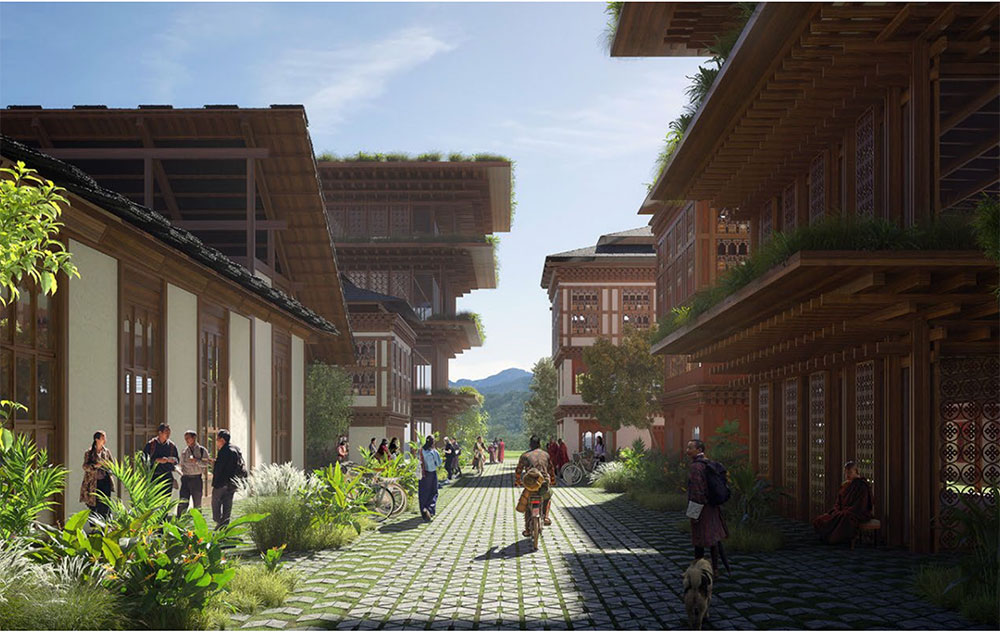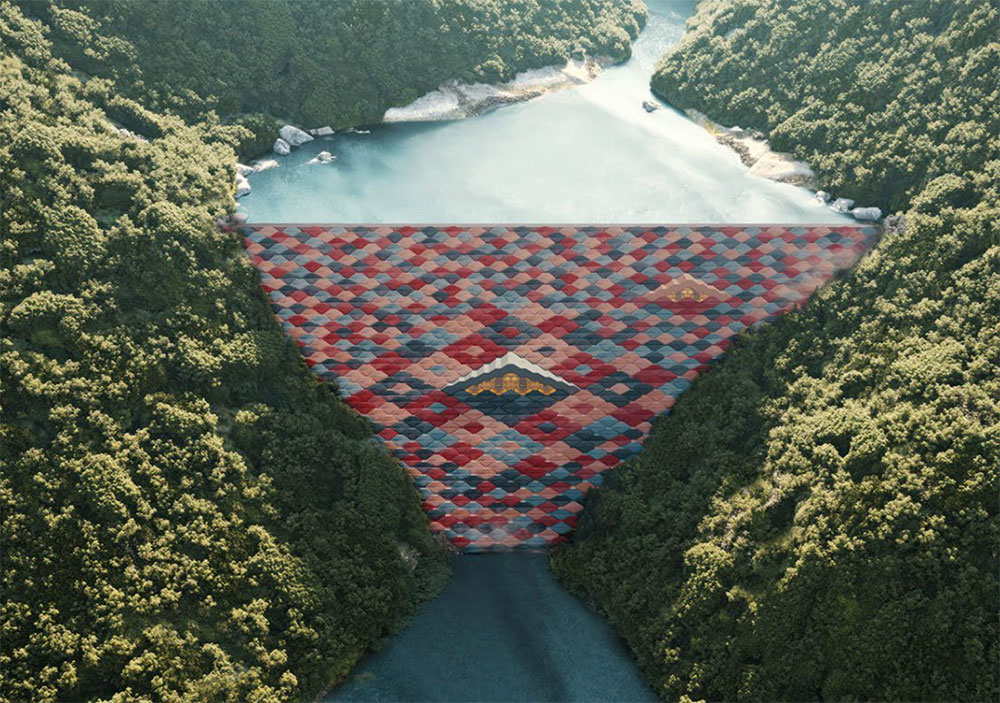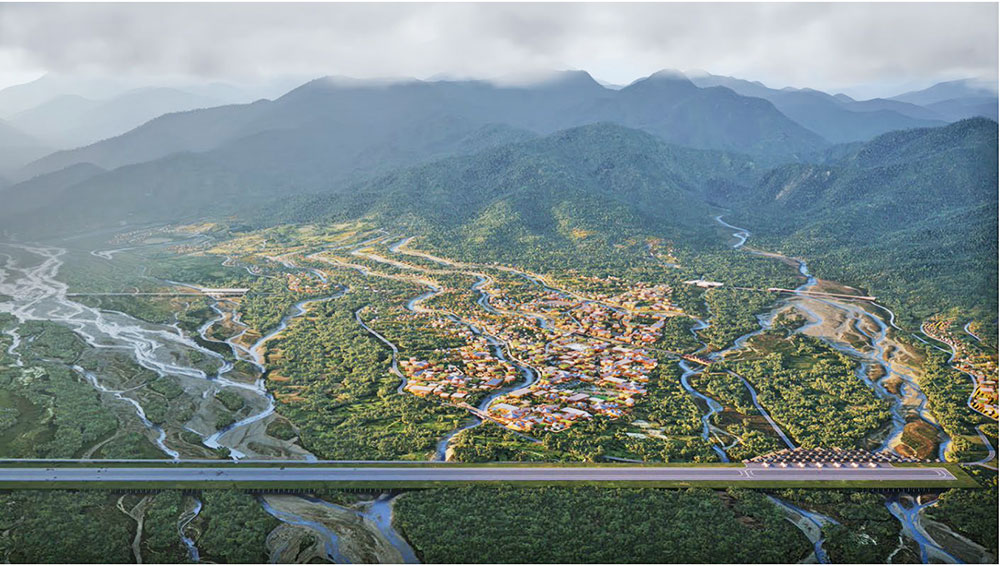Tshering Palden
His Majesty The King shared His vision for a new economic hub in Gelephu in the 116th National Day address to an audience of 30,000 at Changlimithang.
The masterplan, unveiled by His Majesty The King, charts a course for Gelephu to transcend its current status as a small town and evolve into a dynamic Special Administrative Region. Leveraging its strategic location near India and its connection to South and Southeast Asia, the city aims to become a cradle of growth and innovation, while remaining firmly rooted in Bhutan’s unique natural and cultural heritage.
The masterplan vision put together by BIG, Arup, and Cistri, informed by Bhutanese culture, the principles of Gross National Happiness (GNH), and Bhutan’s spiritual heritage.
Amidst the majestic mountains and verdant forests of Bhutan, a bold vision for a city unlike any other has emerged. Gelephu, nestled on the country’s southern border, aspires to become “Mindfulness City,” a 1,000-square-kilometer urban tapestry woven with threads of sustainability, cultural preservation, and economic opportunity for its citizens through investments in green technology, education, and infrastructure.

An architectural representation of street view in the city

An architectural representation of Sunkosh Hydroelectric Dam
Designed by BIG’s Landscape and Urban Design Team, at the heart of this vision lies the concept of Gross National Happiness (GNH), Bhutan’s holistic measure of well-being encompassing nine domains: psychological wellbeing, health, education, living standards, time-use, ecological diversity and resilience, good governance, cultural diversity and resilience, and community vitality. Each of these domains finds expression in the city’s design that includes a new international airport, railway connections, a hydroelectric dam, public spaces, and a language for local building typologies, ensuring a balanced and enriching living environment for its future residents.
Nestled between mountains, forests, and rivers, Bhutan stands as one of the last biodiversity hotspots in the world, with 70 percent of the country covered in forest. Mindfulness City aims to amplify the country’s abundant biodiversity by emerging as a vibrant tapestry of interconnected ecosystems and lively neighbourhoods shaped by the flow of the 35 rivers and streams that run through the site. These neighbourhoods cascade down from the rural highlands to the urban lowlands, reflecting a gradual increase in density while maintaining a deep connection to the natural world.
According to Bjarke Ingels, Founder and Creative Director, BIG – Bjarke Ingels Group, “The Gelephu Masterplan gives form to His Majesty’s vision to create a city that becomes a cradle for growth and innovation while remaining founded on Bhutanese nature and culture. We imagine the Mindfulness City as a place that could be nowhere else. Where nature is enhanced, agriculture is integrated, and tradition is living and breathing, not only preserved but also evolved. Shaped by waterways, Gelephu becomes a land of bridges, connecting nature and people, past and future, local and global.
“Like the traditional Dzongs, these inhabitable bridges turn into cultural landmarks, doubling as transportation infrastructure combined with civic facilities. Among these, the Sunkosh Temple-Dam embeds the city’s fundamental values into a cascading landscape of steps and landings, that like a 21st century Tiger’s Nest will be a man-made monument to the divine possibility of a sustainable human presence on earth. Turning engineering into art and turning the forces of nature into power.”
The natural elements and the existing infrastructure, agriculture, and utilities of Gelephu naturally create eleven distinct neighbourhoods across the more than 1000 square km area. Each of the eleven neighbourhoods is designed based on the principles of the Mandala: defined by a series of repeating typologies organised symmetrically around a central public space, a gradual transition in density is created, from small buildings dispersed in the landscape in the north to larger footprints within an urban environment in the south.
To protect existing and future development against flooding in the monsoon season, paddy fields will be established along the site’s rivers and tributaries, running from north to south. These will further function as biodiversity corridors for local flora and fauna, leaving the migratory routes of elephants and other wildlife undisturbed.
“Inspired by the Bhutanese culture of respect and compassion for others and nature, the Mindfulness City is designed to enhance ecological systems, through an urban development that connects flora and fauna, as well as people and ideas. It becomes a testament of humanity’s inseparable bond with nature, and a global example of how to build a sustainable human presence on Earth,” said Giulia Frittoli, Partner in Charge of BIG Landscape.
The neighbourhoods within the city, which are divided by rivers, are tied together by three main mobility connections. Occasionally, these double as transportation infrastructure combined with civic and cultural facilities, creating a series of ‘inhabitable bridges’ which are tailored to each of the nine Gross National Happiness domains.
Each of the bridges houses key destinations within the city: the new airport, a Vajrayana spiritual centre which allows glimpses into the daily practices of the monks and masters of mindfulness; a healthcare centre as a meeting between Eastern and Western medicine; a university that exposes its academic activities; a hydroponic and aquaponic greenhouse putting ancient farming practices and modern agro-science on display for the daily commuters; a cultural centre to immerse and educate visitors about Bhutanese culture and customs; and a market adorned with Bhutanese textiles.
The final bridge, a hydroelectric dam, will be constructed on the city’s western border with a step-well retaining wall that offers viewpoints, staircases for meditative walks, and a temple. Visitors and pilgrims can ascend and descend along countless individual routes to the visitor centre and temple nested on the face of the manmade cliff. The Sankosh Temple-Dam embodies in architectural form all the foundational elements of Gelephu: the harmonious coexistence of culture and nature, conceived as a hybrid child of Bhutan’s rich past heritage and its prosperous future legacy.
Intimate streets, paved with permeable pavers provide resilience by allowing stormwater to seep into the ground rather than the sewage system. Locally sourced-materials, wood, stone, and bamboo, will be used in the new buildings, inspired by vernacular motifs such as rabsel, cornices, ornaments, and roofscapes.
The architect
Bjarke Ingels is a Danish architect and founder of (BIG) renowned architecture company, who has won numerous architectural prizes, and gained international attention for designing some of the most innovative and unique structures around the world. They include the Mountain Dwelling in Copenhagen, the Danish World Expo 2010 pavilion in Shanghai, hotels in Norway, a museum overlooking Mexico City, and converting an oil industry wasteland into a zero-emission resort on Zira Island off the coast of Baku, Azerbaijan, an integrated flood protection system, the DryLine, which was a winner of the Rebuild By Design competition by the US Department of Housing and Urban Development, among many other notable works.
He was named the 2011 Innovator of the year by the Wall Street Journal, and one of Time Magazine’s most influential people in 2016.


